-
 Mastigoproctus spinifemoratus, a New Species of Giant Vinegaroon (Thelyphonida: Thelyphonidae) from Mexico
Mastigoproctus spinifemoratus, a New Species of Giant Vinegaroon (Thelyphonida: Thelyphonidae) from Mexico -
 Spatio-Temporal Distribution and Population Dynamics of Two Sympatric Species: The Rock Shrimps Sicyonia dorsalis Kingsley, 1878 and Sicyonia typica (Boeck, 1864) (Penaeoidea: Sicyoniidae) on the Coast of Ilhéus, Bahia, Northeastern Brazil
Spatio-Temporal Distribution and Population Dynamics of Two Sympatric Species: The Rock Shrimps Sicyonia dorsalis Kingsley, 1878 and Sicyonia typica (Boeck, 1864) (Penaeoidea: Sicyoniidae) on the Coast of Ilhéus, Bahia, Northeastern Brazil -
 Two New Species of Crayfish of the Genus Cherax (Crustacea, Decapoda, Parastacidae) from Western and Eastern Indonesian New Guinea
Two New Species of Crayfish of the Genus Cherax (Crustacea, Decapoda, Parastacidae) from Western and Eastern Indonesian New Guinea -
 New Cases of Teratology, Albinism, Abnormal Pigmentation, Gynandromorphism, and Injury Healing in Scorpions (Arachnida: Scorpiones)
New Cases of Teratology, Albinism, Abnormal Pigmentation, Gynandromorphism, and Injury Healing in Scorpions (Arachnida: Scorpiones)
Journal Description
Arthropoda
Arthropoda
- formerly Entomology - is an international, peer-reviewed, open access journal on the study of arthropods published quarterly online by MDPI.
- Open Access— free for readers, with article processing charges (APC) paid by authors or their institutions.
- Rapid Publication: first decisions in 18 days; acceptance to publication in 4 days (median values for MDPI journals in the second half of 2024).
- Recognition of Reviewers: APC discount vouchers, optional signed peer review, and reviewer names published annually in the journal.
Latest Articles
Mastigoproctus spinifemoratus, a New Species of Giant Vinegaroon (Thelyphonida: Thelyphonidae) from Mexico
Arthropoda 2025, 3(1), 2; https://doi.org/10.3390/arthropoda3010002 - 16 Jan 2025
Abstract
►
Show Figures
Mastigoproctus Pocock, 1894, is the most speciose genus in the thelyphonid subfamily Mastigoproctinae Speijer, 1933, with eighteen described species distributed from the Southern United States to Colombia and Venezuela. Ten of these species occur in Mexico. In the present contribution, Mastigoproctus spinifemoratus,
[...] Read more.
Mastigoproctus Pocock, 1894, is the most speciose genus in the thelyphonid subfamily Mastigoproctinae Speijer, 1933, with eighteen described species distributed from the Southern United States to Colombia and Venezuela. Ten of these species occur in Mexico. In the present contribution, Mastigoproctus spinifemoratus, sp. nov., is described based on an adult male and two juveniles from Eastern Nuevo León and Southwestern Tamaulipas, Mexico. It differs from five other species of Mastigoproctus, in which spiniform tubercles are present on the retrolateral surface of the pedipalp femur, in the ventrally directed epistome of the carapace, and the absence of an accessory spine on the prodorsal margin of the pedipalp trochanter. The new species raises the number of Mastigoproctus species to nineteen and the number in Mexico to eleven.
Full article
Open AccessFeature PaperArticle
Spatio-Temporal Distribution and Population Dynamics of Two Sympatric Species: The Rock Shrimps Sicyonia dorsalis Kingsley, 1878 and Sicyonia typica (Boeck, 1864) (Penaeoidea: Sicyoniidae) on the Coast of Ilhéus, Bahia, Northeastern Brazil
by
Renzo Gonçalves Tavares, Lucas Rezende Penido Paschoal, Fernanda Jordão Guimarães, Simone Nunes Brandão and Erminda da Conceição Guerreiro Couto
Arthropoda 2025, 3(1), 1; https://doi.org/10.3390/arthropoda3010001 - 13 Jan 2025
Abstract
►▼
Show Figures
Rock shrimps (Sicyonia dorsalis and Sicyonia typica) are commonly caught as bycatch during shrimp trawling along the Brazilian coast, but are not commercially exploited due to their small size and hard carapace. This study evaluated their spatio-temporal distribution, size classes, and
[...] Read more.
Rock shrimps (Sicyonia dorsalis and Sicyonia typica) are commonly caught as bycatch during shrimp trawling along the Brazilian coast, but are not commercially exploited due to their small size and hard carapace. This study evaluated their spatio-temporal distribution, size classes, and sex ratio near the Almada River Estuary, Ilhéus, Bahia, Northeastern Brazil, and tested correlations between environmental factors and species abundance. Samples were collected monthly using double-rig trawl nets in the estuary and along transects at depths of 5–35 m. Bottom water and sediment samples were obtained for analyses of environmental factors. In total, 5336 individuals of S. dorsalis and 303 individuals of S. typica were collected. No individuals were recorded in the estuary. Both species were significantly more abundant between 25 and 35 m, where fine sediment with high levels of organic matter occurred. Considering the temporal variation, their abundance decreased during the rainy season, coinciding with increased river flow. Organic matter content, salinity, and water transparency were the primary environmental factors influencing abundance. Females were generally larger and predominant compared to males, likely due to life cycle dynamics. Despite being congeneric and sympatric, the species exhibited distinct population patterns, possibly to avoid niche overlap and competition.
Full article

Figure 1
Open AccessArticle
Two New Species of Crayfish of the Genus Cherax (Crustacea, Decapoda, Parastacidae) from Western and Eastern Indonesian New Guinea
by
Christian Lukhaup, Rury Eprilurahman and Thomas von Rintelen
Arthropoda 2024, 2(4), 264-293; https://doi.org/10.3390/arthropoda2040019 - 20 Dec 2024
Abstract
►▼
Show Figures
Two new species of the genus Cherax are described and illustrated. Cherax rayko n. sp., endemic to the Bian River drainage basin in the Muting District, in the northern part of the Merauke Regency, South Papua, Indonesia, is described, figured, and compared with
[...] Read more.
Two new species of the genus Cherax are described and illustrated. Cherax rayko n. sp., endemic to the Bian River drainage basin in the Muting District, in the northern part of the Merauke Regency, South Papua, Indonesia, is described, figured, and compared with its closest relatives, Cherax alyciae, Lukhaup, Eprilurahman & von Rintelen, 2018, and Cherax peknyi Lukhaup & Herbert, 2008. The new species may be easily distinguished from both by the shape of the rostrum, the shape of the chelae, the shape of the scaphocerite, and the coloration. Cherax phing n. sp., endemic to the Kali Ombak River drainage basin in the western part of the Kepala Burung (Vogelkop) Peninsula, Southwest Papua, Indonesia, is described, figured, and compared with its closest relatives, Cherax pulcher Lukhaup, 2015a, Cherax boesemani Lukhaup & Pekny, 2008, Cherax wagenknechtae Lukhaup and Eprilurahman, 2022, and Cherax gherardii Patoka, Bláha & Kouba, 2015. The new species may be easily distinguished from the latter species by the shape of the chelae, rostrum, and body and by the coloration. A molecular phylogeny based on a mitochondrial gene fragment, 16S, supports the morphology-based description of the two new species, which can also be clearly distinguished by sequence differences.
Full article

Figure 1
Open AccessArticle
The Prevalence of Egg Parasitoids of Two Cobweb Spiders in a Tropical Urban Gradient
by
Natalia Jiménez-Conejo, Paul E. Hanson, Eduardo Chacón-Madrigal and Geovanna Rojas-Malavasi
Arthropoda 2024, 2(4), 250-263; https://doi.org/10.3390/arthropoda2040018 - 27 Nov 2024
Abstract
►▼
Show Figures
Parasitoidism strongly influences the structure of the spiders’ populations, and it can be affected by environmental factors such as those caused by anthropogenic actions. We studied the prevalence of parasitoids in egg sacs and the proportion of eggs parasitized in each egg sac
[...] Read more.
Parasitoidism strongly influences the structure of the spiders’ populations, and it can be affected by environmental factors such as those caused by anthropogenic actions. We studied the prevalence of parasitoids in egg sacs and the proportion of eggs parasitized in each egg sac of two synanthropic spider species, one native to the American continent (Parasteatoda tepidariorum) and another recently introduced to the Americas (Latrodectus geometricus). We conducted the study at two scales, along an urban gradient (from highly urbanized to rural sites) and in the vegetation surrounding each sampling site (microscale). We expected to find a larger prevalence of parasitoids in the most urbanized sites and around sampling sites with more vegetation. However, we saw more parasitized egg sacs at the intermediate urbanized site for both species, and the vegetation surrounding the sampling sites did not affect the number of parasitized egg sacs. Therefore, conditions in the site with intermediate urban development favored parasitoids. We also found more parasitized egg sacs in P. tepidariorum than in L. geometricus, which is likely a consequence of native parasites not being adapted to a new host. The proportion of eggs parasitized was similar for both species in all sites, which may be related to the behavior (e.g., searching behavior) and number of spider eggs a female parasitoid can parasitize.
Full article

Figure 1
Open AccessFeature PaperArticle
New Cases of Teratology, Albinism, Abnormal Pigmentation, Gynandromorphism, and Injury Healing in Scorpions (Arachnida: Scorpiones)
by
Danniella Sherwood, Victoria Tang, Julien Tchilinguirian, Ludivine Lamare, Seth Croffy, Mark Stockmann, Jay Keller and Valerio Gerace
Arthropoda 2024, 2(4), 226-249; https://doi.org/10.3390/arthropoda2040017 - 21 Nov 2024
Abstract
►▼
Show Figures
Eighteen new cases of teratology and other abnormalities within scorpions are presented, representing new cases of metasomal duplication, mesosomal anomaly, telson anomaly, albinism, and abnormal pigmentation. Furthermore, recently published literature on other scorpion anomalies are tabulated to update the recent 2023 checklist of
[...] Read more.
Eighteen new cases of teratology and other abnormalities within scorpions are presented, representing new cases of metasomal duplication, mesosomal anomaly, telson anomaly, albinism, and abnormal pigmentation. Furthermore, recently published literature on other scorpion anomalies are tabulated to update the recent 2023 checklist of scorpion teratology which charted all known literature up to the aforementioned work.
Full article

Figure 1
Open AccessArticle
Lethal and Sub-Lethal Effects of Spirotetramat on Red Spider Mite, Tetranychus macfarlanei Baker and Pritchard (Acari: Tetranychidae)
by
Farhana Afrose Swarna, Tasfia Hayder, Shreema Mandal Barsa, Powlomee Mondal, Tetsuo Gotoh and Mohammad Shaef Ullah
Arthropoda 2024, 2(3), 212-225; https://doi.org/10.3390/arthropoda2030016 - 12 Sep 2024
Abstract
►▼
Show Figures
The red spider mite, Tetranychus macfarlanei, is a serious pest of many cultivated crops in Bangladesh and other East-Asian and South-East Asian countries, in the Afrotropical, Oriental, and Palearctic regions. Sublethal concentration of pesticides, such as LC15 and LC30 (the
[...] Read more.
The red spider mite, Tetranychus macfarlanei, is a serious pest of many cultivated crops in Bangladesh and other East-Asian and South-East Asian countries, in the Afrotropical, Oriental, and Palearctic regions. Sublethal concentration of pesticides, such as LC15 and LC30 (the concentrations that result in 15 and 30 percent lethality, respectively) impact reproduction, behavior, development, and physiology. This study assessed the effects of different concentrations of spirotetramat, an insecticide that disrupts lipid production, on the biological traits of T. macfarlanei. The LC15, LC30, LC50, and LC90 values were 2.16, 6.57, 20.54, and 332.81 mg·L−1, respectively. Sublethal concentrations (LC15 and LC30) slightly reduced female fecundity but did not significantly affect development duration, pre-oviposition, oviposition period, or longevity compared to the untreated control group. Life table parameters differed between the treated and control groups, with significant reductions in the intrinsic rate of increase (r), the net reproductive rate (R0), and the finite rate of increase (λ) for LC15 and LC30. LC15 and LC30 had negative effects on the intrinsic rate of increase for females. This study demonstrated that lower lethal concentrations of spirotetramat compromised survivability and negatively impacted the life-table parameters of subsequent generations of T. macfarlanei. These findings highlight the importance of sublethal effects in pest control, offering valuable insights for developing more effective and sustainable integrated pest management strategies.
Full article

Graphical abstract
Open AccessArticle
Survival and Growth of Asellus aquaticus on Different Food Sources from Drinking Water Distribution Systems
by
Nikki van Bel, J. Hein M. van Lieverloo, Antonie M. Verschoor, Leonie Pap-Veldhuizen, Wim A. M. Hijnen, Edwin T. H. M. Peeters and Julia Wunderer
Arthropoda 2024, 2(3), 192-211; https://doi.org/10.3390/arthropoda2030015 - 2 Aug 2024
Cited by 1
Abstract
►▼
Show Figures
Invertebrates, including Asellidae, are part of the natural ecosystem of the drinking water distribution system (DWDS) and are known to cause a nuisance to consumers. In addition, recently, the potential role of the species Asellus aquaticus (L. 1758) in the regrowth of
[...] Read more.
Invertebrates, including Asellidae, are part of the natural ecosystem of the drinking water distribution system (DWDS) and are known to cause a nuisance to consumers. In addition, recently, the potential role of the species Asellus aquaticus (L. 1758) in the regrowth of Aeromonas bacteria was published. Aeromonas is included in the Dutch drinking water guidelines as a process parameter, and the guideline values are regularly exceeded. Although neither A. aquaticus nor Aeromonas is associated with health risks, the Evides drinking water utility shows a strong interest in the possible reasons for these exceedances and possible control measures. In surface waters, Asellidae feed mainly on decaying leaves that are abundantly present. These food sources are not present in the DWDS. Therefore, we determined suitable food sources for A. aquaticus in the DWDS. Laboratory experiments show that A. aquaticus individuals survive on biofilm on pipe wall material and loose deposits (sediments) collected from DWDS. Growth and survival rates on these loose deposits were even higher than on the positive control (decaying leaves). As the basis of these loose deposits is inorganic (iron deposits, sand, and pipe particles), the organic matter (living and decaying bacteria, protozoans, fungi, and invertebrates) must be their substrate. These experiments validate hypotheses that Asellidae can grow and survive on organic matter in deposits in DWDS.
Full article

Figure 1
Open AccessCommunication
Acarological Risk of Infection with Borrelia burgdorferi, the Lyme Disease Agent, in Staten Island, New York City
by
Liyang Zhou, Leonid Tsynman, Kamesan Kanapathipillai, Zahir Shah and Waheed Bajwa
Arthropoda 2024, 2(3), 181-191; https://doi.org/10.3390/arthropoda2030014 - 15 Jul 2024
Abstract
Lyme disease, the leading vector-borne ailment in the U.S., annually affects an estimated 476,000 individuals, predominantly in the Northeast and Upper Midwest. Despite its increasing incidence, the evaluation of risk within U.S. cities, including natural public lands, remains inadequate. This study focuses on
[...] Read more.
Lyme disease, the leading vector-borne ailment in the U.S., annually affects an estimated 476,000 individuals, predominantly in the Northeast and Upper Midwest. Despite its increasing incidence, the evaluation of risk within U.S. cities, including natural public lands, remains inadequate. This study focuses on blacklegged tick occurrences and Borrelia burgdorferi infection prevalence in 24 Staten Island parks, aiming to assess Lyme disease exposure risk. Monthly acarological risk index (ARI) calculations from 2019 to 2022 revealed elevated values (0.16–0.53) in specific parks, notably Wolfe’s Pond Park, High Rock Park, Clay Pit Pond Park, Clove Lake Park, and Fair View Park. June (0.36) and November (0.21) consistently exhibited heightened ARIs, aligning with peak tick collection months. Despite stable yearly infection rates at 28.97%, tick densities varied significantly between parks and years. Identifying a high transmission risk in specific parks in Staten Island, a highly urbanized part of New York City, emphasizes the continuous necessity for Lyme disease risk management, even within the greenspaces of large cities.
Full article
(This article belongs to the Topic Ticks and Tick-Borne Pathogens)
►▼
Show Figures

Figure 1
Open AccessArticle
Description of the Early Larval Development in Freshwater Shrimp Atya lanipes Holthuis, 1963 (Decapoda: Caridea: Atyidae) from Puerto Rico
by
Stefani Cruz-Rosa, Ángel S. Estruche-Santos and Omar Pérez-Reyes
Arthropoda 2024, 2(2), 169-180; https://doi.org/10.3390/arthropoda2020013 - 11 Jun 2024
Abstract
►▼
Show Figures
The family Atyidae is composed of species whose existence has been known since the seventeenth century. Widely found in the Caribbean, Atya lanipes is a freshwater scraper/filter feeder shrimp with an amphidromous complex life cycle. Hunte (1975) described the first larval (zoeal) stage
[...] Read more.
The family Atyidae is composed of species whose existence has been known since the seventeenth century. Widely found in the Caribbean, Atya lanipes is a freshwater scraper/filter feeder shrimp with an amphidromous complex life cycle. Hunte (1975) described the first larval (zoeal) stage of the species. However, no scientific study has described the early larval development of this species after the first stage. This study aimed to document the early larval development of Atya lanipes under laboratory conditions and compare its larval development with other previously described species of the Atyidae family. Larval development was recorded by taking daily photos and videos of larval (zoeal) growth using a stereo microscope. Larvae were also preserved in ethanol for further morphological analysis. The results revealed that the best conditions for Atya lanipes development were 30 ppm water salinity, constant gentle aeration, and 27 °C water temperature. Nine stages were identified for the description of the early larval development of Atya lanipes. Early larval stages differ primarily in interstage larval size, the appearance and development of the telson, appendage appearance, growth of antennae and antennules, and pigmentation. The present contribution represents the first study that describes the larval development of the Caribbean shrimp Atya lanipes.
Full article

Figure 1
Open AccessArticle
Description of Limb Anomalies Resulting from Molt Irregularities in Ammothea hilgendorfi (Pycnogonida: Ammotheidae)
by
Antoine Flandroit, Louis Simon and Guillaume Caulier
Arthropoda 2024, 2(2), 156-168; https://doi.org/10.3390/arthropoda2020012 - 25 May 2024
Abstract
►▼
Show Figures
Limb anomalies are widespread and diversified in arthropods. From trilobites to insects, they range from the loss to the addition or fusion of legs and may appear congenitally or be induced experimentally (e.g., amputation or injury). Basal chelicerates pycnogonids, or sea spiders, also
[...] Read more.
Limb anomalies are widespread and diversified in arthropods. From trilobites to insects, they range from the loss to the addition or fusion of legs and may appear congenitally or be induced experimentally (e.g., amputation or injury). Basal chelicerates pycnogonids, or sea spiders, also show deformities. Despite being understudied compared to other arthropods, quite a high diversity of limb malformations has been reported in the literature. The present study reports the leg anomalies of two adult females Ammothea hilgendorfi (Böhm, 1879) observed with duplicated leg podomeres. Both individuals were described ethologically and morphologically. Although the current knowledge on pycnogonids is limited, the anomaly is likely due to a problem in the molting process; the specimens were unable to totally remove their old exuviae, which then stacked after the proximal leg segments. The second specimen also showed other leg deformities, hinting at a problem during the molting process itself. The discussion emphasizes that understanding how pycnogonids normally molt would not only help our understanding of how the abnormal patterns appeared but also put pycnogonids into perspective with other arthropods, a phylum in which they have a key taxonomic position.
Full article

Figure 1
Open AccessCorrection
Correction: de Mazancourt et al. Updated Checklist of the Freshwater Shrimps (Decapoda: Caridea: Atyidae) of Mindoro Island, the Philippines, with a Description of a New Species of Caridina. Arthropoda 2023, 1, 374–397
by
Valentin de Mazancourt, Hendrik Freitag, Kristina von Rintelen, Marivene Manuel-Santos and Thomas von Rintelen
Arthropoda 2024, 2(2), 149-155; https://doi.org/10.3390/arthropoda2020011 - 16 May 2024
Abstract
There was a mistake in Supplementary Table S1 as published in the original publication [...]
Full article
Open AccessArticle
Phylogeography of a Widely Distributed Atlantic Species: The Case of the Ghost Crab Ocypode quadrata (Fabricius, 1787) (Decapoda: Brachyura: Ocypodidae)
by
Ana Francisca Tamburus, Ivana Miranda, Bárbara Benati Naves and Fernando Luis Mantelatto
Arthropoda 2024, 2(2), 130-148; https://doi.org/10.3390/arthropoda2020010 - 8 Apr 2024
Cited by 1
Abstract
►▼
Show Figures
Ocypode Weber, 1795 (Brachyura: Ocypodidae) is popularly known as ghost crab, and encompasses 21 valid species, including Ocypode quadrata (Fabricius, 1787). This species has wide distribution along the Atlantic coast of America, from the USA (Massachusetts) to Brazil (Rio Grande do Sul), Central
[...] Read more.
Ocypode Weber, 1795 (Brachyura: Ocypodidae) is popularly known as ghost crab, and encompasses 21 valid species, including Ocypode quadrata (Fabricius, 1787). This species has wide distribution along the Atlantic coast of America, from the USA (Massachusetts) to Brazil (Rio Grande do Sul), Central America, and Antilles. Such distribution, along with some biological characteristics of its life cycle and the presence of geographic barriers, could lead to genetic structuring. Herein, we evaluate the hypothesis of the presence of geographic barriers using COI and 16S partial gene fragments. The Maximum Likelihood tree suggests the monophyly of O. quadrata, while the values of intraspecific genetic distance along with the star-shaped haplotype network suggested a lack of genetic structure in Brazilian, Panama, and French Guiana populations, probably caused by larval dispersion. USA and Mexico populations may be a new lineage, but we cannot say it with few sequences and with no morphological characters.
Full article

Figure 1
Open AccessArticle
Serendipitous Discovery of Desert Hairy Scorpion Mitogenomes as Bycatch in Venom Data via Nanopore Sequencing
by
Matthew R. Graham, Carlos E. Santibáñez-López, Jessica R. Zehnpfennig, Dylan S. Tillman and Barbara Murdoch
Arthropoda 2024, 2(2), 119-129; https://doi.org/10.3390/arthropoda2020009 - 4 Apr 2024
Abstract
►▼
Show Figures
While originally intending to explore the venom gland microbiome of the desert hairy scorpion Hadrurus arizonensis Ewing, 1928, nanopore sequencing serendipitously recovered complete mitochondrial genomes for this iconic arachnid. Phylogenetic analysis of these high-quality genomes places Hadrurus as sister to Uroctonus, in
[...] Read more.
While originally intending to explore the venom gland microbiome of the desert hairy scorpion Hadrurus arizonensis Ewing, 1928, nanopore sequencing serendipitously recovered complete mitochondrial genomes for this iconic arachnid. Phylogenetic analysis of these high-quality genomes places Hadrurus as sister to Uroctonus, in agreement with some phylogenomic hypotheses. Additionally, we reveal significant genetic variation among individuals from the same population, highlighting the potential of mitogenomics for population genetics and phylogeography. This study showcases the effectiveness and affordability of nanopore sequencing for research with non-model organisms, opening new avenues for investigating arachnid biodiversity, evolution, and biogeography.
Full article
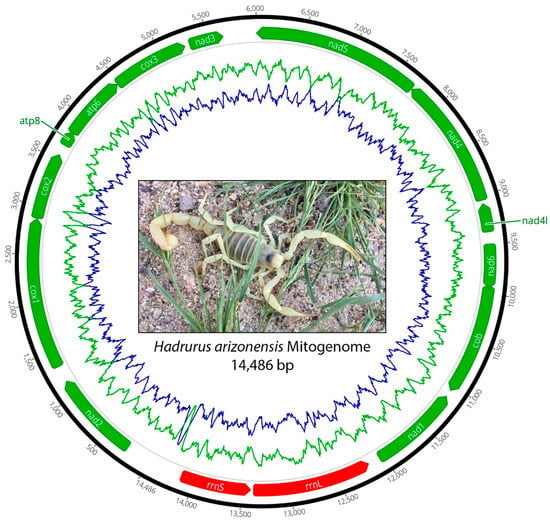
Figure 1
Open AccessArticle
Three New Species of the Freshwater Shrimp Genus Caridina from Australia
by
Werner Klotz, Thomas von Rintelen and Kristina von Rintelen
Arthropoda 2024, 2(1), 99-118; https://doi.org/10.3390/arthropoda2010008 - 18 Mar 2024
Abstract
Three new species of the genus Caridina are described from the northernmost part of Australia. Caridina darwin n. sp. resembles Caridina temasek Choy and Ng, 1991 but differs in the armature of the rostrum, the development of epipods on the pereiopods and the
[...] Read more.
Three new species of the genus Caridina are described from the northernmost part of Australia. Caridina darwin n. sp. resembles Caridina temasek Choy and Ng, 1991 but differs in the armature of the rostrum, the development of epipods on the pereiopods and the absence of an appendix interna on the male first pleopods. Caridina magnovis n. sp. resembles Caridina serratirostris de Man, 1892 but differs in the armature of the ventral margin of the rostrum, a shorter stylocerite, a stouter carpus of the first pereiopod, the number and size of spiniform setae on the third and fifth pereiopods, the shape of the preanal carina and the size of the embryos (referred to as “eggs” in most previous publications). Caridina wilsoni n. sp. resembles Caridina gracilirostris de Man, 1892 but differs in the size of the embryos and in some length to width ratios of the segments of the pereiopods. Detailed morphological descriptions of all three new species are given. A molecular phylogeny (mt DNA 16S) supports the morphospecies hypothesis and illustrates the phylogenetic relationship with morphologically similar species from outside Australia.
Full article
(This article belongs to the Special Issue Alpha-Level Taxonomy of Decapod Crustaceans)
►▼
Show Figures
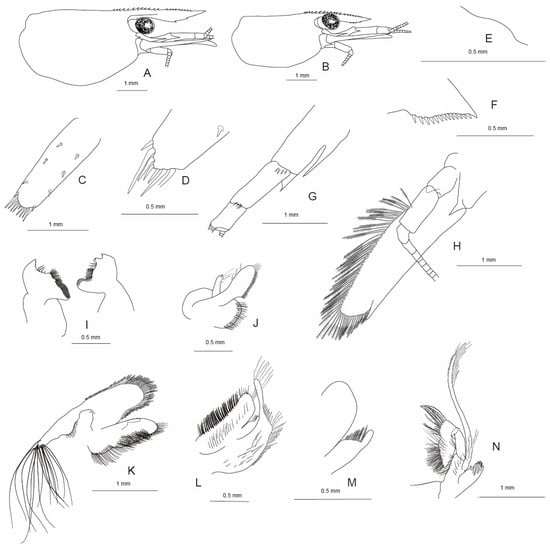
Figure 1
Open AccessArticle
Evolutionary Conservation and Diversification of Five Pax6 Homologs in the Horseshoe Crab Species Cluster
by
Tanay Dakarapu and Markus Friedrich
Arthropoda 2024, 2(1), 85-98; https://doi.org/10.3390/arthropoda2010007 - 4 Mar 2024
Abstract
►▼
Show Figures
Horseshoe crabs represent the most ancestral chelicerate lineage characterized by marine ecology and the possession of lateral compound eyes. While considered living fossils, recent studies reported an unusual number of Pax6 genes in the Atlantic horseshoe crab Limulus polyphemus. Pax genes encode
[...] Read more.
Horseshoe crabs represent the most ancestral chelicerate lineage characterized by marine ecology and the possession of lateral compound eyes. While considered living fossils, recent studies reported an unusual number of Pax6 genes in the Atlantic horseshoe crab Limulus polyphemus. Pax genes encode ancient metazoan transcription factors, which comprise seven subfamilies. Among these, the members of the Pax6 subfamily confer critical functions in the development of the head, the visual system, and further body plan components. Arthropods are generally characterized by two Pax6 subfamily homologs that were discovered in Drosophila and named eyeless (ey) and twin of eyeless (toy). However, whole genome sequence searches uncovered three homologs of ey and two homologs of toy in L. polyphemus. These numbers are explained by the occurrence of likely three whole genome duplications in the lineage to the last common ancestor of L. polyphemus and the three additional members of the extant horseshoe crab species cluster. Here, we report that all five L. polyphemus Pax6 paralogs are conserved in the approximately 135-million-year-old horseshoe crab species cluster and that they evolve under strong purifying selection. Largely homogenous protein sequence diversification rates of ey and toy paralogs suggest subfunctionalization as the likeliest preservation trajectory. However, our studies further revealed evidence that the horseshoe crab ey1 and ey2 paralogs share a derived splice isoform that encodes a unique five amino acid-long insertion in helix 3 of the homeodomain. This suggests that the exceptional expansion of the horseshoe crab Pax6 gene family repertoire was also associated with regulatory diversification and possibly innovation.
Full article

Figure 1
Open AccessArticle
On the Identity of Neostenotarsus guianensis (Caporiacco, 1954), with a Redescription of the Holotype Male and the First Records from Guyana (Araneae: Theraphosidae)
by
Danniella Sherwood and Ray Gabriel
Arthropoda 2024, 2(1), 76-84; https://doi.org/10.3390/arthropoda2010006 - 1 Mar 2024
Abstract
►▼
Show Figures
Herein, we redescribe Neostenotarsus guianensis (Caporiacco, 1954) nearly seven decades after its original description. In the original description of Neostenotarsus scissistylus Tesmoingt & Schmidt, 2002, we found characters incongruent with N. guianensis, namely, the purported presence of serration on the prolateral keels
[...] Read more.
Herein, we redescribe Neostenotarsus guianensis (Caporiacco, 1954) nearly seven decades after its original description. In the original description of Neostenotarsus scissistylus Tesmoingt & Schmidt, 2002, we found characters incongruent with N. guianensis, namely, the purported presence of serration on the prolateral keels of the palpal bulb; a narrower apical third of the embolus; the absence of a patch of bristles on the retrolateral face of the palpal tibia and of a baso-retrolateral protuberance on metatarsus I; and a shorter and more apically situated megaspine on the retrolateral branch of the tibial apophyses. The characters from its original description are discussed. N. scissistylus stat. rev. has been revalidated until such time as the type material, or topotypic material, can be examined by future workers.
Full article
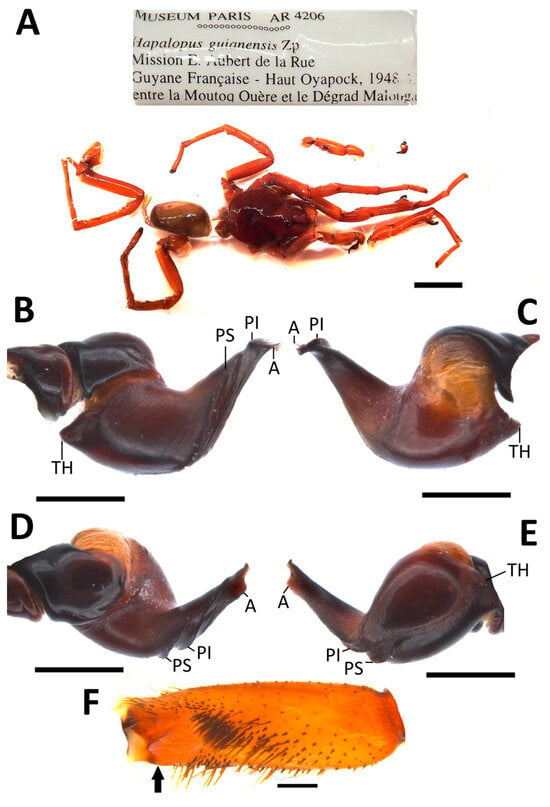
Figure 1
Open AccessArticle
An Indo-West Pacific Distribution for the Coral-Dwelling Gall Crab Lithoscaptus doughnut (Decapoda: Cryptochiridae)
by
Jorn R. Claassen, Yosephine Tuti and Sancia E. T. van der Meij
Arthropoda 2024, 2(1), 66-75; https://doi.org/10.3390/arthropoda2010005 - 18 Feb 2024
Abstract
►▼
Show Figures
Coral-dwelling gall crabs (Cryptochiridae) are common inhabitants of scleractinian corals. Several species have been described as new in recent years, including Lithoscaptus doughnut, which was described from Hong Kong based on a single female retrieved from the coral Plesiastrea peroni. Here
[...] Read more.
Coral-dwelling gall crabs (Cryptochiridae) are common inhabitants of scleractinian corals. Several species have been described as new in recent years, including Lithoscaptus doughnut, which was described from Hong Kong based on a single female retrieved from the coral Plesiastrea peroni. Here we extend the distribution range of L. doughnut with nine additional localities throughout the Indo-West Pacific, from the Red Sea to the Coral Triangle and Japan. We describe a male specimen of L. doughnut for the first time, based on a specimen from Malaysia, and provide photographs of life and preserved material. Haplotype networks based on COI mtDNA (n = 12) and 16 rRNA sequences (n = 12) were created. We retrieved eleven COI haplotypes and six 16S haplotypes, however no clear geographic distribution pattern was discerned. Intraspecific variation in L. doughnut was 1.4% for COI and 0.2% for 16S. Lastly, the first colour photos and records of associated parasites of this species are provided.
Full article
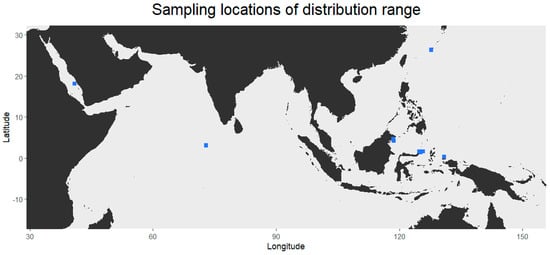
Figure 1
Open AccessArticle
How Urban-Tolerant Are They? Testing Prey–Capture Behavior of Introduced Jorō Spiders (Trichonephila clavata) Next to Busy Roads
by
Andrew K. Davis, Kade Stewart, Caitlin Phelan and Alexa Schultz
Arthropoda 2024, 2(1), 55-65; https://doi.org/10.3390/arthropoda2010004 - 13 Feb 2024
Cited by 2
Abstract
►▼
Show Figures
An invasive orb-weaving spider from east Asia is now spreading through the southeastern United States; Trichonephila clavata (the “jorō spider”) makes large, imposing webs seemingly everywhere, including in urban landscapes, and even next to busy roads. However, areas near roads come with frequent
[...] Read more.
An invasive orb-weaving spider from east Asia is now spreading through the southeastern United States; Trichonephila clavata (the “jorō spider”) makes large, imposing webs seemingly everywhere, including in urban landscapes, and even next to busy roads. However, areas near roads come with frequent disturbances, including auditory and vibrational, which for many animals, leads to physiological or behavioral changes. Here we tested if varying levels of road traffic affect the prey–capture behavior of jorō spiders in northeast Georgia. We visited roadsides that ranged in traffic density and exposed nearby jorō spiders to a simulated prey (a tuning fork at 128 hz frequency, touched to the web), and recorded whether or not the spider attacked it. Out of 357 total trials across 20 different roads, jorō spiders attacked the simulated prey 59% of the time, but at the local scale, there was high variability in this rate; at some roadsides, over 80% of the spiders attacked, while at others, less than 30% did. When all roads were considered collectively, there was a small but significant (negative) correlation between daily road traffic and spider attack rates. Put another way, spiders near moderate- to heavy-traffic roads were slightly less likely to attack than those near low-traffic roads (51% vs. 65%). Jorō spiders appear to be able to live near roads, but this does come with a cost in terms of prey capture. However, spiders near busier roads did not weigh less than those in other sites, suggesting they may be able to compensate for the disturbance. These findings add to the accumulating evidence around this species that points to its ability to exist in human-dominated landscapes, which will likely aid its spread in the introduced range.
Full article
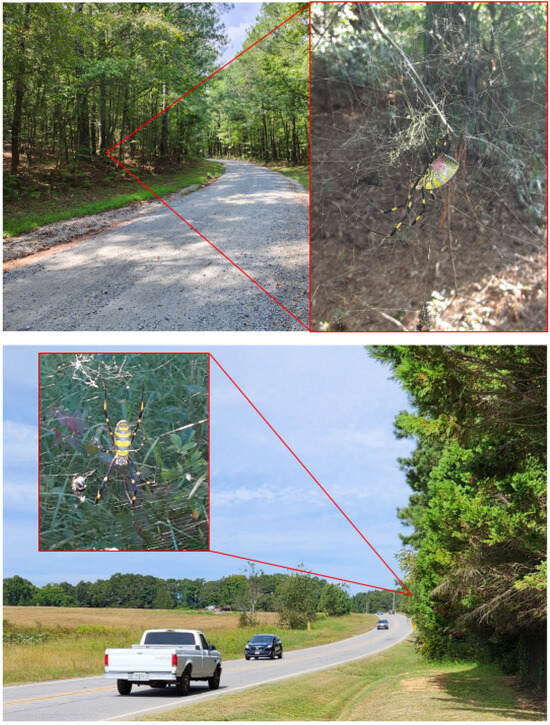
Figure 1
Open AccessArticle
Composition, Distribution, and Biodiversity of Zooplanktons in Tropical Lentic Ecosystems with Different Environmental Conditions
by
Wahidah Ahmad Dini Umi, Fatimah M. Yusoff, Zetty Norhana Balia Yusof, Norulhuda Mohamed Ramli, Artem Y. Sinev and Tatsuki Toda
Arthropoda 2024, 2(1), 33-54; https://doi.org/10.3390/arthropoda2010003 - 31 Jan 2024
Cited by 1
Abstract
A study was conducted to evaluate zooplankton species composition, abundance, and diversity in both natural and artificial lakes with varying trophic levels and to determine the relationship between zooplankton community structure and lake environmental conditions. This study hypothesized that correlations exist between zooplankton
[...] Read more.
A study was conducted to evaluate zooplankton species composition, abundance, and diversity in both natural and artificial lakes with varying trophic levels and to determine the relationship between zooplankton community structure and lake environmental conditions. This study hypothesized that correlations exist between zooplankton community structures and environmental parameters associated with eutrophication in natural and artificial lakes. Sampling was conducted across 16 distinct freshwater lentic ecosystems in Malaysia, including natural lakes/swamps, reservoirs, constructed lakes/ponds, and old mining lakes, spanning a range of trophic levels from mesotrophic to hypereutrophic conditions. Physicochemical parameters were measured in situ, while water and zooplankton samples were collected for nutrient analyses, as well as for zooplankton identification and enumeration. Throughout this study, a total of 58 zooplankton species, consisting of 36 species of rotifers, 12 species of cladocerans, and 10 species of copepods, were recorded. The highest zooplankton density (365.7 ± 13.7 ind L−1) was recorded in constructed lakes/ponds while the lowest density was recorded in natural shallow lakes/swamps (200.5 ± 25.5 ind L−1). On the other hand, significantly higher (p < 0.05) mean species diversity was observed in natural lakes/swamps (H’ = 2.2 ± 0.0); whereas, the lowest diversity was in old mining lakes (H’ = 1.5 ± 0.1). The canonical correspondence analysis (CCA) scores indicated that Polyarthra vulgaris and Chydorus ventricosus were the discriminating species in natural shallow lakes/swamps associated with high water transparency. Meanwhile, the small-sized cladocerans (Ceriodaphnia cornuta) and rotifers (Keratella spp., Brachionus spp., and Trichocerca spp.) were the most discriminating species in lakes with high turbidity, nutrients, and chlorophyll a concentrations, which are the main features of reservoirs and constructed lakes/ponds. Low density and diversity in old mining lakes were due to a low species number and the dominance of two species, Lophocharis curvata (38.8%) and Ptygura libera (39.7%). Overall, the high dominance of a specific zooplankton species resulted in lower biodiversity in artificial ecosystems compared to natural ecosystems. This study elucidated that zooplankton community structure in lakes was significantly influenced by the environmental conditions related to the lake trophic status.
Full article
(This article belongs to the Special Issue Integrative Taxonomy of Cladocera and Copepoda)
►▼
Show Figures
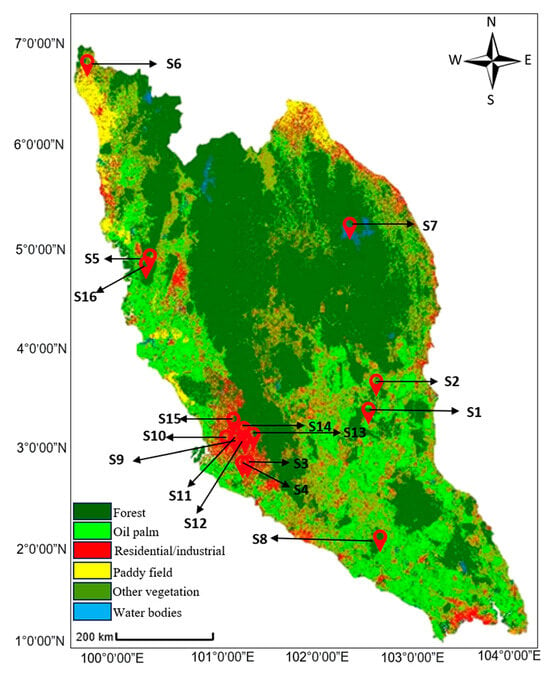
Figure 1
Open AccessCommunication
A New Record of the Rare Crab Homolodromia robertsi Garth, 1973 (Crustacea; Decapoda; Homolodromiidae), from Cocos Island, Costa Rica
by
Christopher B. Boyko and Peter K. L. Ng
Arthropoda 2024, 2(1), 28-32; https://doi.org/10.3390/arthropoda2010002 - 17 Jan 2024
Abstract
In the American Museum of Natural History, New York, there is an old specimen labelled as “Holodromia harrisonwilliamsi Boone, MS name” that was collected from Cocos Island in 1925. This name has never been published. An examination of the specimen shows that
[...] Read more.
In the American Museum of Natural History, New York, there is an old specimen labelled as “Holodromia harrisonwilliamsi Boone, MS name” that was collected from Cocos Island in 1925. This name has never been published. An examination of the specimen shows that it is a juvenile specimen of Homolodromia robertsi Garth, 1973, a species described from Peru, which has since been reported from Chile and off the coast of Ecuador. This paper reports on the specimen Homolodromia robertsi Garth found in Costa Rica for the first time, a discovery that extends the known range of this species northwards.
Full article
(This article belongs to the Special Issue Alpha-Level Taxonomy of Decapod Crustaceans)
►▼
Show Figures
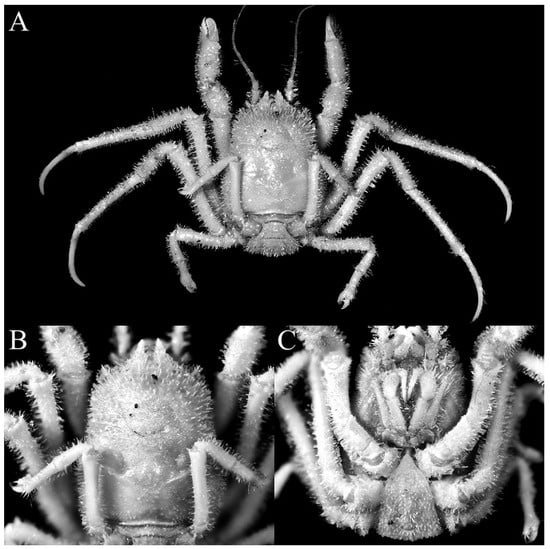
Figure 1
Highly Accessed Articles
Latest Books
E-Mail Alert
News
Topics
Topic in
Animals, Arthropoda, Insects, Pathogens, Vaccines, Veterinary Sciences
Ticks and Tick-Borne Pathogens
Topic Editors: Alina Rodriguez-Mallon, Alejandro Cabezas-CruzDeadline: 31 March 2025
Topic in
Animals, Arthropoda, Diversity, Insects, Life, Pathogens
Arthropod Biodiversity: Ecological and Functional Aspects, 2nd Edition
Topic Editors: Paolo Solari, Roberto M. Crnjar, Anita GiglioDeadline: 31 January 2026

Conferences
Special Issues
Special Issue in
Arthropoda
Integrative Taxonomy of Cladocera and Copepoda
Guest Editors: Maciej Karpowicz, Carlos LópezDeadline: 31 March 2025
Special Issue in
Arthropoda
Sustainable Management of Arthropod Pests in Agriculture
Guest Editors: Ting Li, Olufemi Ajayi, Fang (Rose) ZhuDeadline: 31 October 2025





